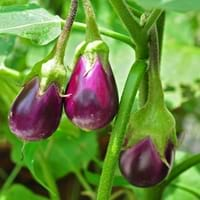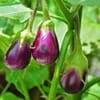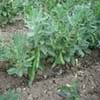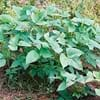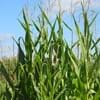Life Span
Perennial
Perennial
Type
Vegetable
Flowering Plants, Shrubs
Origin
Africa, Asia
Africa, America, Asia
Types
Not Available
Lockinch, Petite Indigo, White Profusion
Number of Varieties
Not Available
Habitat
Cultivated Beds
Along Railroads, River side, Roadsides
USDA Hardiness Zone
10-15
5-10
Sunset Zone
A1, A2, A3, H1, H2, 1a, 1b, 2a, 2b, 3a, 3b, 4, 5, 6, 7, 8, 9, 10, 11, 12, 13, 14, 15, 16, 17, 18, 19, 20, 21, 22, 23, 24
H1, 2a, 2b, 3a, 3b, 4, 5, 6, 7, 8, 9, 10, 11, 12, 13, 14, 15, 16, 17, 18, 19, 20, 21, 22, 23, 24
Habit
Clump-Forming
Arching/Fountain-shaped
Flower Color
Lavender
Blue, Pink, Purple, Red, White
Flower Color Modifier
Bicolor
Not Available
Fruit Color
White, Purple, Plum, Black
Not Available
Leaf Color in Spring
Green
Gray Green
Leaf Color in Summer
Green
Gray Green, Light Green
Leaf Color in Fall
Green
Gray Green, Light Green, Yellow green
Leaf Color in Winter
Green
Not Available
Leaf Shape
Elliptic
Egg-shaped
Plant Season
Summer, Fall
Fall, Spring, Summer, Winter
Sunlight
Full Sun
Full Sun, Part sun, Partial shade
Growth Rate
Very Fast
Fast
Type of Soil
Clay, Loam, Sand
Loamy, Sandy, Well drained
The pH of Soil
Neutral
Neutral, Slightly Acidic, Slightly Alkaline
Soil Drainage
Well drained
Well drained
Bloom Time
Indeterminate
Spring
Tolerances
Drought
Drought, Pollution, Salt, Soil Compaction
Where to Plant?
Ground
Ground, Pot
How to Plant?
Seedlings
Seedlings, Stem Planting, Transplanting
Plant Maintenance
Medium
Medium
Watering Requirements
Do not water frequently, Needs less watering, Over-watering can cause leaf problems or root diseases, Water Deeply
Form a Soil ring to water efficiently, Water Deeply, Water twice a day in the initial period
In Summer
Lots of watering
Lots of watering
In Spring
Moderate
Moderate
In Winter
Average Water
Average Water
Soil pH
Neutral
Neutral, Slightly Acidic, Slightly Alkaline
Soil Type
Clay, Loam, Sand
Loamy, Sandy, Well drained
Soil Drainage Capacity
Well drained
Well drained
Sun Exposure
Full Sun
Full Sun, Part sun, Partial shade
Pruning
Remove damaged leaves, Remove dead branches, Remove dead leaves
Cut or pinch the stems, Prune for shortening long shoots, Prune if you want to improve plant shape, Prune ocassionally, Remove damaged leaves, Remove dead or diseased plant parts, Remove deadheads, Remove shoots
Fertilizers
All-Purpose Liquid Fertilizer, Apply N-P-K, Less fertilizing
All-Purpose Liquid Fertilizer
Pests and Diseases
Aphids, Leaf spot, Red blotch
Downy mildew, Leaf spot, Spider mites
Plant Tolerance
Drought, Shade areas
Drought
Flower Petal Number
Single
Single
Fragrant Bark/Stem
Yes
No
Foliage Texture
Medium
Medium
Foliage Sheen
Matte
Matte
Attracts
Not Available
Butterflies, Hummingbirds
Allergy
Throat itching
Vomiting
Aesthetic Uses
Not Used For Aesthetic Purpose
Showy Purposes
Beauty Benefits
Not Available
Not Available
Environmental Uses
Air purification
Air purification
Medicinal Uses
Antidote, Astringent
Not Available
Part of Plant Used
Fruits, Leaves
Flowers, Leaves
Other Uses
Not Available
Showy Purposes, Used as Ornamental plant
Used As Indoor Plant
No
No
Used As Outdoor Plant
Yes
Yes
Garden Design
Container, Edible, Herb, Vegetable
Edging, Feature Plant, Foundation
Botanical Name
SOLANUM melongena 'Ichiban'
Buddleia davidii
Common Name
brinjal
melongene
garden egg
guinea squash
Butterfly Bush, Summer Lilac, Butterflybush
In Hindi
जापानी बैंगन
Butterfly Bush
In German
japanische Aubergine
Schmetterlingsstrauch
In French
aubergine japonaise
buisson de papillon
In Spanish
Berenjena japonesa
arbusto de las mariposas
In Greek
Ιαπωνικά Μελιτζάνα
Butterfly Μπους
In Portuguese
Beringela japonesa
arbusto de borboleta
In Polish
japoński Bakłażan
Butterfly Bush
In Latin
Eggplant Italica
papilio rubo
Phylum
Tracheophyta
Spermatophyta
Class
Magnoliopsida
Dicotyledonae
Family
Solanaceae
Scrophulariaceae
Clade
Angiosperms, Asterids, Eudicots
Angiosperms, Asterids, Eudicots
Tribe
Not Available
Not Available
Subfamily
Not Available
Not Available
Number of Species
Not Available
Season and Care of Japanese Eggplant and Butterfly Bush
Season and care of Japanese Eggplant and Butterfly Bush is important to know. While considering everything about Japanese Eggplant and Butterfly Bush Care, growing season is an essential factor. Japanese Eggplant season is Summer and Fall and Butterfly Bush season is Summer and Fall. The type of soil for Japanese Eggplant is Clay, Loam, Sand and for Butterfly Bush is Loamy, Sandy, Well drained while the PH of soil for Japanese Eggplant is Neutral and for Butterfly Bush is Neutral, Slightly Acidic, Slightly Alkaline.
Japanese Eggplant and Butterfly Bush Physical Information
Japanese Eggplant and Butterfly Bush physical information is very important for comparison. Japanese Eggplant height is 60.00 cm and width 30.00 cm whereas Butterfly Bush height is 7.50 cm and width 4.00 cm. The color specification of Japanese Eggplant and Butterfly Bush are as follows:
Japanese Eggplant flower color: Lavender
Japanese Eggplant leaf color: Green
Butterfly Bush flower color: Blue, Pink, Purple, Red and White
- Butterfly Bush leaf color: Gray Green
Care of Japanese Eggplant and Butterfly Bush
Care of Japanese Eggplant and Butterfly Bush include pruning, fertilizers, watering etc. Japanese Eggplant pruning is done Remove damaged leaves, Remove dead branches and Remove dead leaves and Butterfly Bush pruning is done Cut or pinch the stems, Prune for shortening long shoots, Prune if you want to improve plant shape, Prune ocassionally, Remove damaged leaves, Remove dead or diseased plant parts, Remove deadheads and Remove shoots. In summer Japanese Eggplant needs Lots of watering and in winter, it needs Average Water. Whereas, in summer Butterfly Bush needs Lots of watering and in winter, it needs Average Water.
